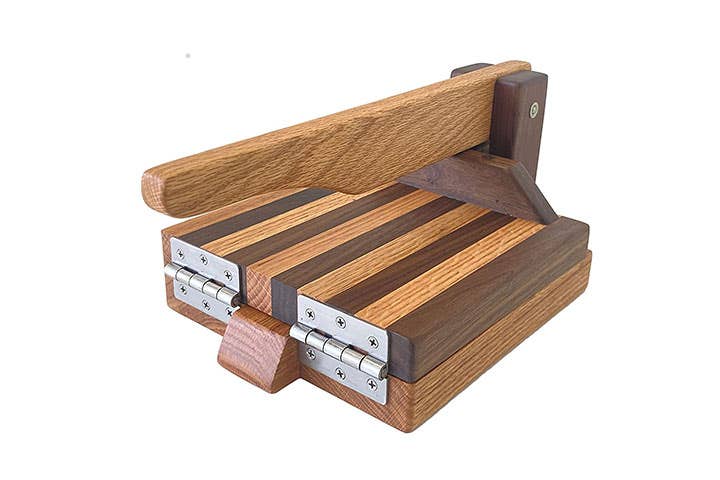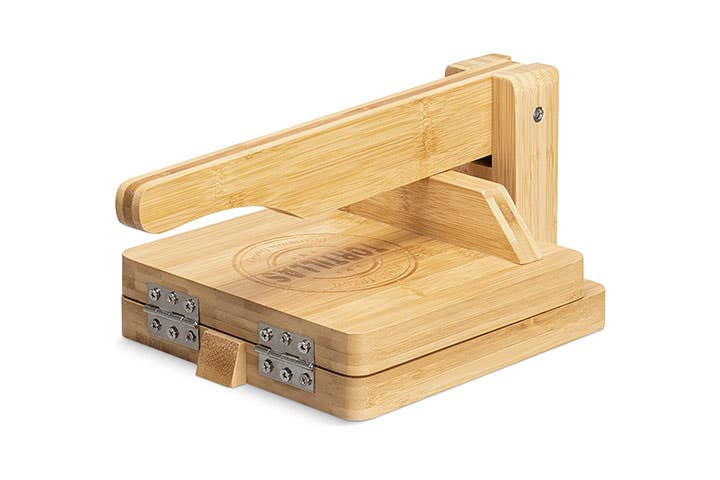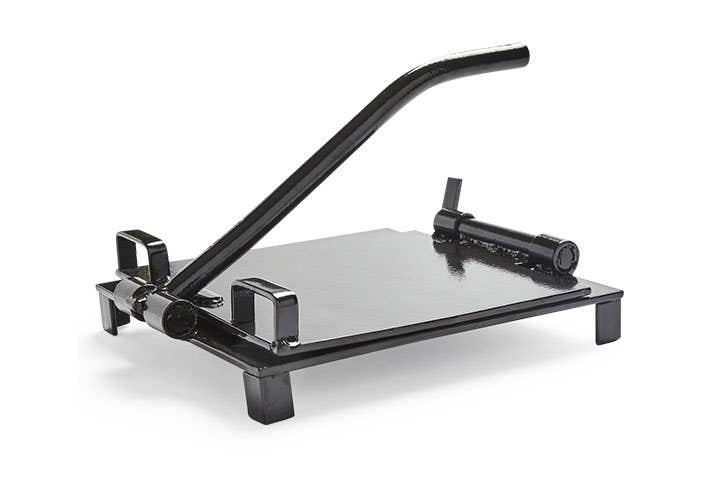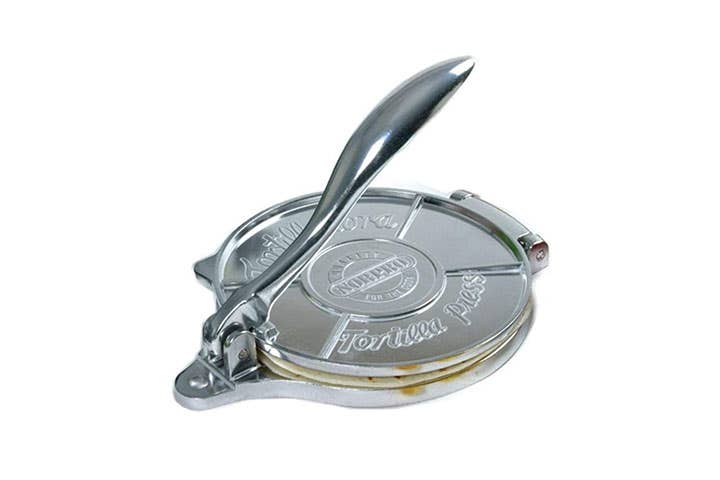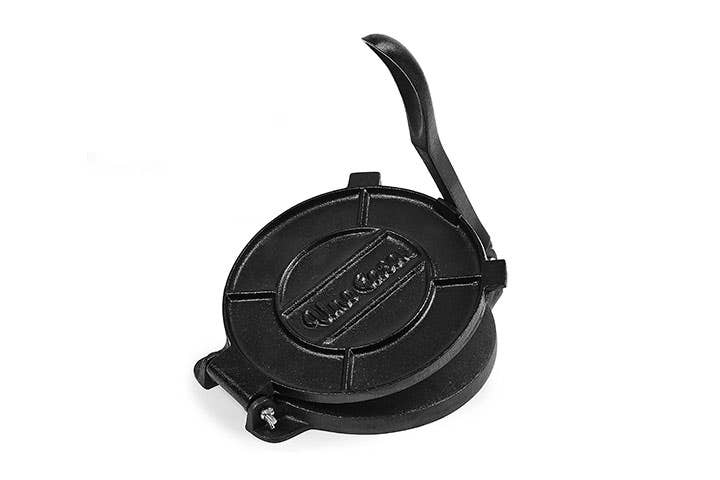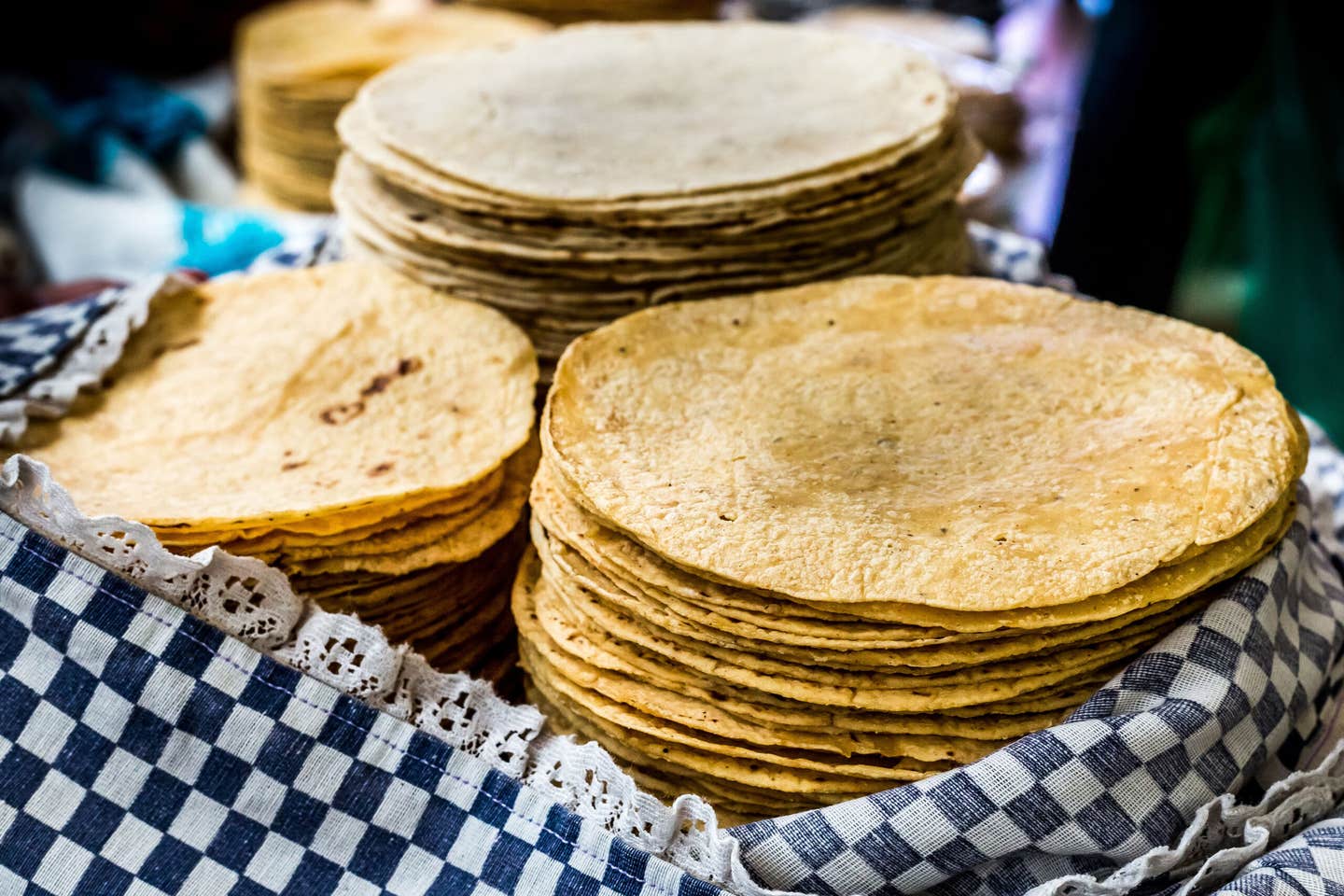
Learning to make tortillas at home always seemed like an impossible task, even after years of watching my favorite Mexican grandmothers press dozens before breakfast and studying the swift motions of the women turning them out at restaurants and roadside stands. But while practice makes perfect, over the years, I've also found that better equipment and supplies make that practice far less frustrating.
First, I started replacing my grocery store standard Maseca with high quality dried masa (I like Alma Semillera), then to fresh masa when someone started making it in my city—that would be Perla Ruiz, of Milpa Masa, who also steered me toward the best tortilla press we found. Then I started upgrading my press—from a cheap, wobbly raw wood version that was sharp, splintery, and difficult to clean, to a mid-range cast iron model. But I struggled with the idea of upgrading further, because I wasn't sure the fancy presses would be any better.
With the help of Janet Becerra, a chef who spent time in the kitchen at Mexico City's Pujol and serves creative twists on the foods of her heritage at her Seattle pop-up Pancita, I now know the answer: they are better.
But first, she demonstrated how to make that ideal tortilla after it comes off the press. Becerra expertly lifted her tortillas off the press with her first two fingers, allowing her to gently lay them down on the medium-high heat of the flat top. She let the edges of each tortilla just curl up before flipping them so that the rough face or "cara" of the tortilla showed. When that started to rise, she flipped them again, pushing down on the edges of the smooth side, encouraging each tortilla to inflate. As they finished cooking, she places them inside a cloth holder, with the cara facing up. Ruiz later explained that this keeps the tortillas from sticking together as they finish cooking with the steam in the holder.
Using this method and the best tortilla presses, even my own messier and clumsier tortillas puffed up perfectly every time. But even more impressively, Becerra made stacks of expert-level tortillas even as she tested our many products and gave a tour of what makes the best tortilla presses.
Our Top Picks
- Best Overall: Central Coast Woodworks Red Oak and Walnut Tortilla Press - 8 Inch
- Best Value: Navaris Wooden Tortilla Press
- Best Metal: Doña Rosa x Masienda Tortilla Press
- Best for Small Space: Norpro 6 Inch Tortilla Maker
- Best Budget Metal: Uno Casa Cast Iron Tortilla Press - 8 Inch
Best Overall
Material: Red Oak and Walnut Wood | Tortilla Size: Medium | Weight: 6.24 lbs.
Pros
- Beautiful aesthetics
- Smooth, luxurious feel
- Presses evenly
Cons
- Price
Why we chose it: This stunning, handcrafted piece makes pressing perfect tortillas a breeze.
"The best tortilla press in the world," Ruiz said before the testing, and she turned out to be correct. This artfully made press makes art-level tortillas every time. The smooth-sanded wood and rounded edges feel good to hold, and the mechanisms work smoothly, giving just enough feedback to leave the control in the hands of the user, and the surfaces meet evenly to make flat tortillas. Small details, like that the handle doesn't flip all the way over the back (which would require more space and additional movement), take the design head-and-shoulders above others. The only drawbacks are that you do pay more for the higher quality, and that wood presses are naturally somewhat bulkier. But anyone who makes tortillas enough to invest in the best possible tool and with the storage space to keep this around will find it the most worthwhile investment.
Best Value: Navaris Wooden Tortilla Press
Best Value
Material: Bamboo | Tortilla Size: Medium | Weight: 4.4 lbs.
Pros
- User-friendly
- Well-crafted
- Easy to clean
Cons
- Sharp corners on handle
- Handle rotation
Why we chose it: This bamboo press has many of the same advantages as the winning hardwood model, at half the cost.
Lighter, cheaper, and just a smidge less good than the best-in-class version, this makes a pretty good dupe for anyone not quite ready to spring for the gold-standard. The mechanics work well, the pieces all seem to hold firm, and it easily presses out nice, even tortillas. The downsides come where it diverges from the Central Woodworks design: the edges of the squared off handle are just less comfortable to hold, points out Becerra, and the handle rotates all the way backward, requiring a significantly larger area to use, and more motion to press each tortilla. Like all wood presses, it takes up some storage space, but the light weight makes it easier to move around.
Best Metal: Doña Rosa x Masienda Tortilla Press
Best Metal
Material: Powder-coated Iron | Tortilla Size: Medium | Weight: 10.4 lbs.
Pros
- Color options
- Makes thin tortillas
- Nice feel
Cons
- Size and weight
- Price
Why we chose it: This pretty, user-friendly, Mexican-made press brings high-quality to a traditional look and feel.
The heft of metal presses makes lighter work for the user, especially when the quality keeps the parts moving smoothly. Masienda, a company that imports corn and other ingredients for making traditional Mexican food, brings this in from a Oaxacan producer and paints them in a variety of colors—something both Ruiz and Becerra mentioned liking. Becerra also mentioned the comfortable feel of the handle, both the size and the round metal, as a perk of this press. The flat surfaces press together nicely, and the heaviness of the top means less effort is required from the user. As ever, this type of craftsmanship commands a steeper price than mass-produced items, but the results justify it. The downside of the weight of a good metal press, though, is that this is both bulky and heavy, making storage an additional challenge.
Best for Small Space: Norpro 6 Inch Tortilla Maker
Best for Small Space
Material: Aluminum | Tortilla Size: Small | Weight: 1.5 lbs.
Pros
- Small
- Lightweight
- Price
Cons
- Flimsy
- Requires more exertion than heavier models
Why we chose it: If you have a tiny kitchen, this wee, ultra-light press will slide into even the smallest of spaces.
Apartment dwellers with closet-sized kitchens that can't fathom storing an enormous press will find the secret to tortilla making in this little model. Sadly, the same attributes that make it so useful for the kind of people who use their oven to store pans also give it a lot of downsides. The lightness means that most of the force needs to come from the person, and at the same time, the flimsiness fails to give the user much control. It's annoying for experts, but will be a detriment to newer makers who could struggle to turn out the kind of tortillas that make pressing your own worth it.
Best Budget Metal: Uno Casa Cast Iron Tortilla Press - 8 Inch
Best Budget Metal
Material: Cast Iron | Size: Medium | Weight: 7.39 lbs.
Pros
- Good weight
- Can feel nuance
- Size
Cons
- Subpar construction
Why we chose it: This classic-style cast iron tortilla press makes a good middle-of-the-road option for people looking to start making tortillas at home.
Small enough to store, but heavy enough to do most of the work for you, well-made enough to turn out consistent, good tortillas, but still affordable enough for newcomers, this simple cast iron model makes an excellent entry point for new tortilla pressers. While Becerra noted that she wished the weight ratio leaned a little more to the top, overall, the heaviness of this press means it does most of the work. The handle, even when the screw is tightened to its maximum, wiggles a bit from side to side—this doesn't affect the tortilla, but does feel cheap and annoying. However, the handle also communicates well, letting the user feel the nuance of the tortilla they are pressing, an important skill to learn on a tortilla making journey. It also comes with a set of parchment paper, which is not what experts prefer, but is a good option for beginners and helps remove another obstacle.
How We Chose These Products
Using purchased and borrowed presses of varying sizes, we pressed tortillas using both fresh masa and dough made from dried masa flour. Each press was tested by both a novice maker and by Becerra, our expert tester. We spoked with both Becerra and Ruiz before the testing, in gathering product recommendations, and after, to discuss results. We looked at each press for quality and ease of use, as well as the practicality in the kitchen, then evaluated the tortillas they produced.
Features to Keep in Mind When Shopping for Tortilla Presses
Material
The most important element of choosing a tortilla press is the material: heavier iron presses do much of the work for you, but also are heavier to store and move. Super light materials, like aluminum, have the opposite issue. Different types of wood fall in between on that scale, but in general finding an ideal press involves figuring out your personal preference and tolerance for the weight of the press. Wood and cast iron both offer nice aesthetics, but wood models tend to be larger, while the metal ones vary in size, depending on the style, even among ones that make the same size tortillas.
Weight
The weight of a press matters in both the production and storage. Heavier presses require less force to press the same tortilla. For a few tortillas, every once in a while, this matters little. But to crank out a big batch, it is nice to think and work less, letting the machine do the work. However, the heavier press makes it harder to move and store—Becerra says that a back injury sometimes makes it difficult for her to carry her own press to the car when she brings it to pop-ups. Wood tends to be lighter, and well-made wood presses create leverage that helps to take the onus off the user.
Maintenance
Most tortilla presses, especially when used properly with plastic or parchment barriers, require little maintenance beyond a wipe down with a damp towel after each use. Cast iron presses benefit from a light seasoning with oil after wiping them down, while the occasional coating of mineral oil is good for many wood presses. For lower-quality presses, some of the screws may need to be retightened or even replaced as they can wiggle loose with use.
Size
Purchase a tortilla press that matches the size of tortillas you wish to make. For small, two-bite tacos, like the kind sometimes referred to as "street tacos," look for a six-inch press. For an average, medium-sized tortilla, look for an eight-inch tortilla press. Beyond that, larger presses can get more difficult to transfer the dough, warns Becerra, but they can be used for big tortillas and other things, like tlayudas.
Manual vs. Electric
For corn tortillas, there is no reason to venture into electric tortilla presses. While both Ruiz and Becerra prefer to roll their flour tortillas, the best way to press a flour tortilla is with the addition of heat, hence the category of electric tortilla presses.
Ask the Experts
Q: How do I clean a cast iron tortilla press?
Just wipe it down with a towel dampened with warm water, and then season it, explains Ruiz.
Q: How do I season a tortilla press?
Season a cast iron press by rubbing a thin layer of cooking oil onto it after cleaning, which Becerra says will help prevent rust.
Q: How do I use a tortilla press?
Place a barrier—plastic wrap works well— on the press, then place a ball of masa down in the center, explains Becerra. She likes to squish it down a bit first to ensure a more evenly round better shape. Then she adds a second barrier, closes the press, and pushes the handle down. She then opens the press and rotates the enclosed masa 180 degrees, and presses again to even it out. Then, leaving it on the press, she peels off the top barrier, then flips it back on to that piece of plastic before peeling off the second barrier. Then she transfers it to her first two fingers at the top edge of the tortilla so she can easily move it over to the cooking surface.
Q: What else can you make with a tortilla press?
While Ruiz has never ventured away from tortillas, Becerra uses hers for all manner of Mexican antojitos, including tetelas, memelas, tlacoyos, and on larger presses, tlayudas and even huaraches.
Q: Is it better to roll or press flour tortillas?
While pressing balls of masa for corn tortillas results in an excellent shape and texture, flour tortillas are a little different. Rather than pressing flour tortillas in a press, it's best to roll them with a rolling pin. "I'm 'Team Roll,'" says Becerra, and Ruiz agrees, saying she tried pressing flour dough once and can verify it did not work.
Q: How do I keep dough from sticking to the tortilla press?
Both Ruiz and Becerra prefer plastic as their barrier of choice. Becerra uses two pieces cut from a thick reusable grocery bag, while Ruiz uses pieces of plastic designed to separate hamburger patties, which she has found to be the exact right size.
Our Take
The more you make tortillas, the better a press you will want. For people who make them often and have the space and budget, the higher-quality, artisan-made presses are an easy choice. The choice gets harder for people purchasing their first press, but the best mid-range options make it easier to commit to the purchase and work well enough to last well into your journey to tortilla expertise.
Keep Reading
Continue to Next Story
